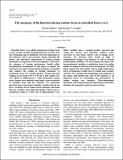| dc.contributor.author | Danos, N. | |
| dc.contributor.author | Lauder, George V. | |
| dc.date.accessioned | 2017-03-06T18:15:44Z | |
| dc.date.issued | 2007 | |
| dc.identifier.citation | Danos, N., and G. V. Lauder. 2007. The Ontogeny of Fin Function During Routine Turns in Zebrafish Danio Rerio. Journal of Experimental Biology 210, no. 19: 3374–3386. doi:10.1242/jeb.007484. | en_US |
| dc.identifier.issn | 0022-0949 | en_US |
| dc.identifier.uri | http://nrs.harvard.edu/urn-3:HUL.InstRepos:30510319 | |
| dc.description.abstract | Zebrafish Danio rerio exhibit spontaneous, routine turns as part of their normal foraging behavior from the early free-swimming stage to adulthood. Given the importance of this behavior and its pervasiveness during zebrafish life history, the functional requirements of routine turning should play an important role in development. Conversely, the ontogeny of turning performance should reflect morphological development. In this paper we analyze the kinematics of routine turning during ontogeny in zebrafish and compare the scaling of turning kinematics to predictions from two existing models. Twenty-nine fish ranging in size from 0.38 to 1.97·cm in fork length (FL) were filmed at 1000·frames·s–1 while performing routine turns. Images were analyzed using image cross-correlation to calculate body and fin velocities. We performed piecewise linear regression to identify variables that do not have a constant rate of change across ontogeny and found that two variables, turn angle and angular velocity, have a transition in slope at a body size of approximately 1·cm. Other variables show a constant positive (pectoral and caudal fin velocity, turn duration), negative (body curvature) or zero (head velocity) rate of change across ontogeny. We interpret these trends in light of morphological changes over ontogeny as well as relevant hydrodynamic conditions. We also compare the slope of the log-transformed variables to predictions from two scaling models of change in function with increasing size. We find mixed support for both models with no single model being better at predicting a single type of variable such as linear velocities. We conclude that morphological development of the paired and median fins and of the skeleton, is an important factor in determining the performance of routine turning over ontogeny. Three-dimensional kinematics and ecological behavior information will further elucidate the ontogenetic patterns observed here. | en_US |
| dc.description.sponsorship | Organismic and Evolutionary Biology | en_US |
| dc.language.iso | en_US | en_US |
| dc.publisher | The Company of Biologists | en_US |
| dc.relation.isversionof | doi:10.1242/jeb.007484 | en_US |
| dash.license | LAA | |
| dc.subject | ontogeny | en_US |
| dc.subject | locomotion | en_US |
| dc.subject | scaling | en_US |
| dc.subject | danio rerio | en_US |
| dc.title | The ontogeny of fin function during routine turns in zebrafish Danio rerio | en_US |
| dc.type | Journal Article | en_US |
| dc.description.version | Version of Record | en_US |
| dc.relation.journal | Journal of Experimental Biology | en_US |
| dash.depositing.author | Lauder, George V. | |
| dc.date.available | 2017-03-06T18:15:44Z | |
| dc.identifier.doi | 10.1242/jeb.007484 | * |
| dash.contributor.affiliated | Lauder, George | |


